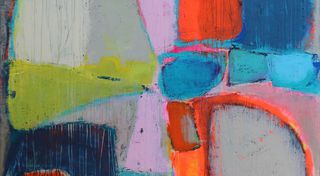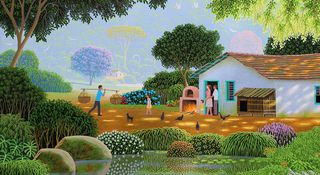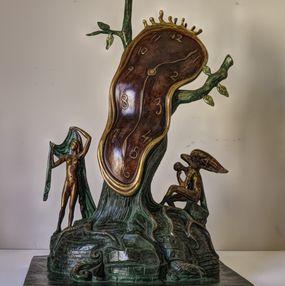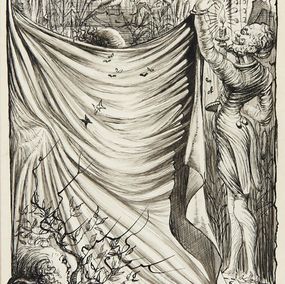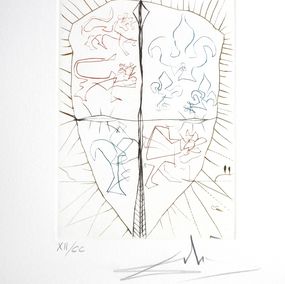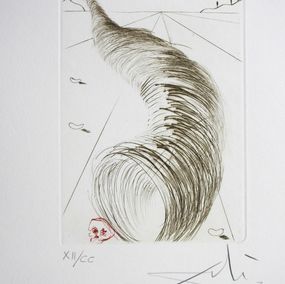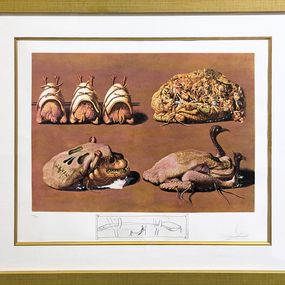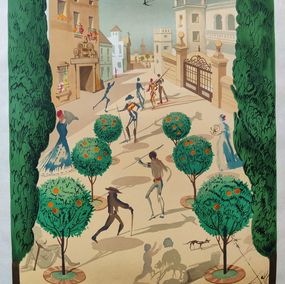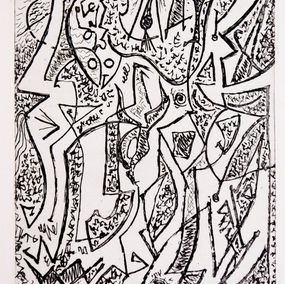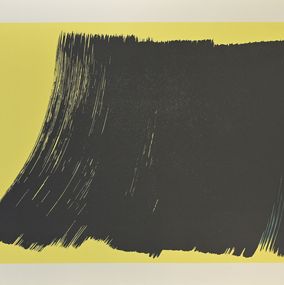
The Woman Taken in Adultery,
1972
Salvador Dali
Print : dry point, etching
45 x 31 x 0.1 cm 17.7 x 12.2 x 0 inch
Second NOT DISPLAYED BLUR TEXT
Free returns within 14 days
Authenticity guaranteed
Learn moreSecure payment
About the artwork
Type
Numbered and limited to 125 copies
1 copy available
Signature
Hand-signed by artist
Authenticity
Sold with certificate of Authenticity from the gallery
Invoice from the gallery
Medium
Dimensions cm • inch
45 x 31 x 0.1 cm 17.7 x 12.2 x 0 inch Height x Width x Depth
Support
Framing
Not framed
Tags
Artwork sold in perfect condition
Artwork location: Italy
(Image 18 x 13 cm; Sheet 45 x 31 cm).
Hand signed and numbered 49/125, Publisher Transworld Art, New York - Friburg. Ref. Michler & Lopsinger, n. 557.
Imagine it at home
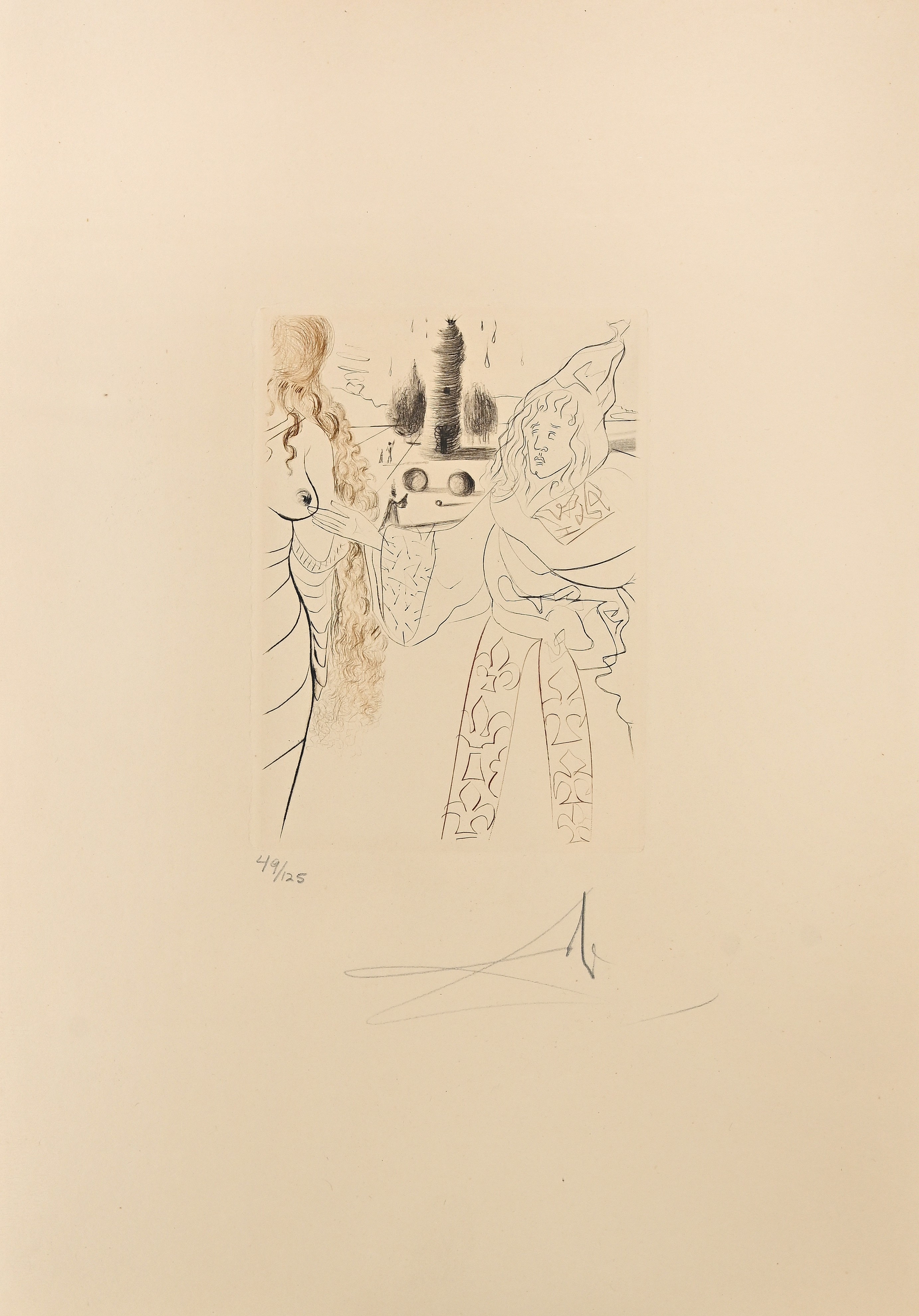
Discover more by the artist
Presentation
Salvador Dalí (1904–1989) remains one of the most influential figures in the art world, celebrated for his surrealist works that have captivated collectors and art lovers globally. His innovative approach to abstraction, vivid imagination, and technical skill have earned him a permanent place in art history. Dalí's surrealist masterpieces, featuring dreamlike landscapes and symbolic imagery, continue to be among the most sought-after works in the contemporary art market.
In 2024, Dalí's legacy was highlighted through major exhibitions and events. The Dalí Museum in St. Petersburg, Florida, hosted a groundbreaking immersive experience, offering visitors a deeper understanding of Dalí's artistic genius. Additionally, the Monthaven Arts and Cultural Center in Tennessee presented an exhibition of Dalí's powerful illustrations for Dante's Divine Comedy, showcasing his ability to evoke profound emotion and surreal visions through his artwork.
Dalí's works continue to perform exceptionally well in the auction world. His painting Rose Méditative (1958) sold for over $4 million at a Sotheby's auction in Paris in November 2024, significantly surpassing its estimate, further solidifying his appeal to art collectors and investors. Dalí's pieces consistently command impressive prices at major auctions, reinforcing his status as one of the most valuable artists on the market.
Born in Figueres, Spain, Dalí was initially influenced by Impressionism and Cubism before encountering Surrealism in the late 1920s. Inspired by Sigmund Freud's theories on the unconscious, Dalí developed his “paranoiac-critical method," a technique that allowed him to access and depict his subconscious mind, creating some of the most iconic images in modern art. Works like The Persistence of Memory (1931) are symbols of his ability to transform the ordinary into the extraordinary.
Dalí's creative talents extended beyond painting to include film, sculpture, and literature. He collaborated with Luis Buñuel on the films Un Chien Andalou (1928) and L'Âge d'Or (1930), which continue to be celebrated for their provocative, surreal imagery. Dalí also wrote The Secret Life of Salvador Dalí (1942), an autobiography that offers insights into his eccentric personality and artistic philosophy.
Dalí's works are housed in major collections worldwide, including the Dalí Theatre-Museum in Spain and the Dalí Museum in Florida. His art continues to inspire new generations of collectors, artists, and art enthusiasts, ensuring his place as one of the most beloved and significant figures in the history of modern art. With his bold, imaginative creations, Salvador Dalí's art continues to shape and inspire the art market and artistic culture globally.
More works from Wallector Srl
Artsper delivers internationally. The list of countries is available in the first step of your cart.
If your country is not listed contact us at [email protected] and we will see what we can do.
Note that Customs fees may apply for works shipped internationally. This is indicated in the first step of the shopping cart.
You can choose a delivery address different from the billing address. Make sure that a trusted person is present to receive the work if you cannot be there.
Have you purchased a painting, sculpture or work on paper?
Find our expert advice for the conservation and promotion of your works in the articles below:
Artsper offers you access to more than 200,000 works of contemporary art from 2,000 partner galleries. Our team of experts carefully selects galleries to guarantee the quality and originality of the works.
You benefit from:
-
Works at gallery price
-
Return within 14 days, regardless of your location
-
Easy resale of the work purchased on Artsper
-
Personalized research tools (selection and tailor-made universe)
Our customer service is available for any assistance.
At Artsper, our mission is to allow you to collect works of art with complete peace of mind. Discover the protections we offer at every stage of your shopping experience.
Buy works from top galleries
We work in close collaboration with carefully selected art galleries. Each seller on Artsper is carefully examined and approved by our team, thus ensuring compliance with our code of ethics. You therefore have the assurance of purchasing authentic, high-quality works.
Total transparency: you know what you are buying
Before being posted online, all artwork on Artsper is reviewed and validated by our moderation team. You can browse with complete peace of mind, knowing that each piece meets our criteria of excellence.
Personalized support: our experts at your service
Our team of contemporary art experts is available by phone or email to answer all your questions. Whether you want advice on a work or a tailor-made selection to enrich your collection, we are here to support you.
Resell your works with ease
If you have purchased a work on Artsper and wish to resell it, we offer you a dedicated platform to relist it. To find out more, click here.
Make offers with Artsper: negotiate like in a gallery
You have the possibility to propose a price for certain works, just like in a gallery. This feature allows you to initiate discussions and potentially acquire your coins at advantageous prices.
Get help with your negotiations
Our team will negotiate for you and inform you as soon as the best offer is obtained. Do not hesitate to call on our expertise to ensure a transaction at the best price.
Order securely
Artsper satisfaction assurance
We want you to be completely satisfied with your purchase. If the work you receive is not to your liking, you have 14 days to return it free of charge, and you will be refunded in full, whatever the reason.
Secure payment with Artsper partners
All credit card payments are processed by Paybox, the world leader in payment solutions. Thanks to their strict security standards, you can transact with confidence.
Problem Support
In the rare event that an artwork arrives damaged or not as described, we are here to help. Whether for a return, refund, restoration or exchange, our team will support you throughout the process and will ensure that we find the solution best suited to your situation.
Conditions to benefit from Artsper protections:
-
Use one of the payment methods available on Artsper for your order.
-
Report any problems within one week of receiving the work.
-
Provide required photographic evidence (including original artwork and packaging).
Artsper guarantees cover the following cases:
-
The received work lacks a described characteristic (for example, a signature or frame).
-
The artwork has significant differences from its description (e.g. color variation).
-
The work is damaged upon receipt.
-
The work is lost or damaged by the carrier.
-
Delivery is significantly delayed.
With Artsper, you collect with complete peace of mind.
